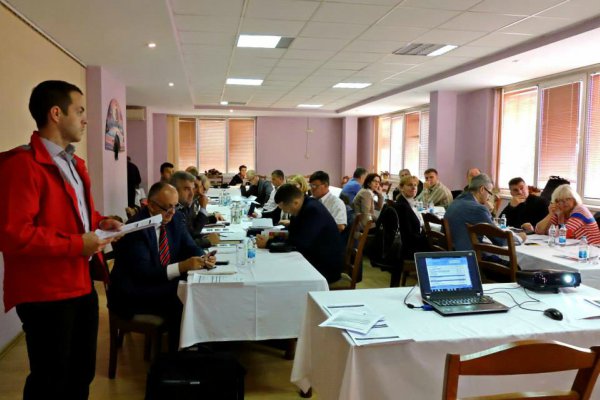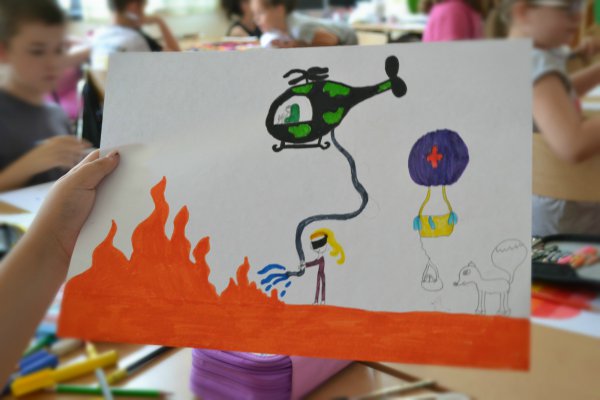 North West Balkans
North West Balkans
Languages
Creating disaster resilient environments for children
Today we mark the International Day for Disaster Reduction – opportunity to encourage every citizen and government to take part in building more disaster resilient communities.
Natural disasters that hit Bosnia and Herzegovina (B-H) and Serbia in 2014, causing immense material damage and affecting 3.27 million persons in both countries, were a wake-up call for all stakeholders to improve protection and preparedness systems and thus minimalize losses in cases of natural or other disasters. After active engagement in humanitarian response to 2014 floods and landslides, Save the Children now focuses on Disaster Risk Reduction (DRR) programmes.
Save the Children’s DRR projects target six locations in B-H – Gradacac, Samac, Maglaj, Srebrenica, Sanski Most and Brcko District and one in Serbia – Obrenovac. All of these locations were selected because they have been severely affected by the floods in May 2014.
Through these projects, Save the Children intends to focus on working with key actors in the local communities, who are the first line responders in case of an emergency, to ensure that the learning, capacities and procedures are in place for rapid response. This will be achieved through development and enforcement of protection and rescue action plans that include clear protocols and Standard Operating Procedures for child protection in emergencies at local level. Such plans are already adopted by municipalities Gradacac and Samac and by the primary schools “M. C. Catic” and “S. B. Basagic” from Gradacac and “Novi Seher” and “Maglaj” from Maglaj.
“As an organisation that primarily focuses on improving of situation and protection of children, it is important to us that the action plans are concentrated on children, that all stakeholders put children first, and to scale up planned activities with children, teachers and school administrations onto higher, local administration level. Through this project we will aim to integrate our previous experiences and methodologies in working with children in emergencies into action plans for emergencies,” stressed Save the Children in North West Balkans Director Andrea Zeravcic.
In order to ensure full implementation of the program’s objectives, Save the Children signed memorandums of understanding with relevant municipal authorities as well as with representatives of the primary and high schools that are participating in the program.
“This is a comprehensive project that tackles all possible forms of disasters that can happen in our region, action plans to respond to disasters, training, risk assessment that is comprehensive and that will be consisting of elements prepared by the entity civil protection body, public institutions and Save the Children… In any case, we will have very realistic data, field training and concrete tasks, and I am confident that, in case of any potential disaster, the consequences will be minimal,” stated Head of Samac Municipality Savo Minic.
DRR program in B-H is implemented in close partnership with the Ministry of Security of Bosnia and Herzegovina and its Department for Rescue and Protection.
“This project is a continuation of a long lasting cooperation of the Ministry with Save the Children. It is very important that these municipalities get risk assessments in relation to natural and other disasters and protection and rescue plans in line with the entities’ assessments and European standards that are applied in this sector. In the past period, we had numerous problems caused by the floods and landslides, there were many mishaps and we hope that through these trainings institutions at the local level will adopt standards that are being implemented in developed countries and they will be ready to face potential disaster risks in the future,” emphasized Head of the Department for Rescue and Protection Idriz Brkovic.

From January 2015, when implementation of the program commenced, until today, 42 representatives of local administration, public and education institutions from B-H attended 4 training programs aimed to increase their preparedness for emergencies and strengthen their capacities to respond promptly and adequately to any related risks. Training programs are specially designed to introduce disaster risk reduction standards, protection and rescue systems and legislation and to review existing assessments that the participating institutions have in place.
“During the very first presentation at the training, I noticed that we had very little information with regards to protection and rescue system, so I hope to bring back to my school and share with my colleagues lots of information. I also hope we will use this information to improve the safety of our students, because our school has the highest number of students of all schools in Gradačac,” said Deputy Director of primary school “Safvet beg Basagic” Amela Mehmedovic after the training in May 2015.
In the second phase of the program implementation in B-H, Save the Children also intends to provide children of pre-school and primary school age and their teachers with relevant information and skills that will build their resilience and their capacity to protect themselves and their peers in an event of an emergency. The planned workshops include exercises and simulations of various disasters in order to increase awareness and provide practical knowledge.
In Serbia, Save the Children started with developing the methodology for integration of DRR in extra-curricular activities of primary and secondary schools, building capacities of school management teams, teachers and children to cope with natural hazard related risks and developing school disaster management plans. By now, more than 40 teachers from Obrenovac improved their knowledge on DRR issues and increased capacities for direct work with children through trainings and mentorship support. In addition, capacities of 956 students in three primary and one secondary school improved to better cope with natural hazard related risks through participation in workshops organized within extra-curricular activities. Serbian Ministry of Education endorsed Save the Children’s efforts and the organisation became official member of the inter-sectoral group for integration of DRR in formal curricula.

“Earthquake” was the topic of the workshop for students of the primary school “Posavski partizani” in Obrenovac, held in June this year. “During the workshop, students developed a sense of responsibility and solidarity. They were helping each other and supporting each other in a simulated difficult and unexpected situation. Workshops like this one are significant and necessary for schools in order to keep students informed about the disaster risks and how to react when disasters happen. Such workshops increase students’ safety while in school, but also provide them with new skills they can apply out of school as well,” stressed physics teacher from this school, Maja Dimkovic.
By improving the capacities of all stakeholders, including municipal authorities, local level community services, education institutions, civilian protection and civil society (e.g. Red Cross), Save the Children intends to improve the position of children and ensure that their needs are planned for and adequately met in an event of an emergency during initial immediate and all other phases of the response at local level.
